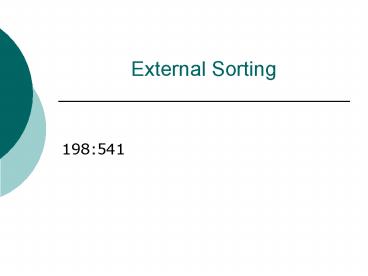External Sorting PowerPoint PPT Presentation
Title: External Sorting
1
External Sorting
- 198541
2
Why Sort?
- A classic problem in computer science!
- Data requested in sorted order
- e.g., find students in increasing gpa order
- Sorting is first step in bulk loading B tree
index. - Sorting useful for eliminating duplicate copies
in a collection of records (Why?) - Sort-merge join algorithm involves sorting.
- Problem sort 1Gb of data with 1Mb of RAM.
3
2-Way Sort Requires 3 Buffers
- Pass 1 Read a page, sort it, write it.
- only one buffer page is used
- Pass 2, 3, , etc.
- three buffer pages used.
INPUT 1
OUTPUT
INPUT 2
Main memory buffers
Disk
Disk
4
Two-Way External Merge Sort
Input file
6,2
2
3,4
9,4
8,7
5,6
3,1
- Each pass we read write each page in file.
- N pages in the file gt the number of passes
- So toal cost is
- Idea Divide and conquer sort subfiles and merge
PASS 0
1-page runs
1,3
2
3,4
5,6
2,6
4,9
7,8
PASS 1
4,7
1,3
2,3
2-page runs
8,9
5,6
2
4,6
PASS 2
2,3
4,4
1,2
4-page runs
6,7
3,5
6
8,9
PASS 3
1,2
2,3
3,4
8-page runs
4,5
6,6
7,8
9
5
General External Merge Sort
- More than 3 buffer pages. How can we utilize
them?
- To sort a file with N pages using B buffer pages
- Pass 0 use B buffer pages. Produce
sorted runs of B pages each. - Pass 2, , etc. merge B-1 runs.
INPUT 1
. . .
. . .
INPUT 2
. . .
OUTPUT
INPUT B-1
Disk
Disk
B Main memory buffers
6
Cost of External Merge Sort
- Number of passes
- Cost 2N ( of passes)
- E.g., with 5 buffer pages, to sort 108 page file
- Pass 0 22 sorted runs of 5
pages each (last run is only 3 pages) - Pass 1 6 sorted runs of 20
pages each (last run is only 8 pages) - Pass 2 2 sorted runs, 80 pages and 28 pages
- Pass 3 Sorted file of 108 pages
7
Number of Passes of External Sort
8
Using B Trees for Sorting
- Scenario Table to be sorted has B tree index on
sorting column(s). - Idea Can retrieve records in order by traversing
leaf pages. - Is this a good idea?
- Cases to consider
- B tree is clustered Good idea!
- B tree is not clustered Could be a very bad idea!
9
Clustered B Tree Used for Sorting
Index
- Cost root to the left-most leaf, then retrieve
all leaf pages (Alternative 1) - If Alternative 2 is used? Additional cost of
retrieving data records each page fetched just
once.
(Directs search)
Data Entries
("Sequence set")
Data Records
- Always better than external sorting!
10
Unclustered B Tree Used for Sorting
- Alternative (2) for data entries each data entry
contains rid of a data record. In general, one
I/O per data record!
Index
(Directs search)
Data Entries
("Sequence set")
Data Records
11
Summary
- External sorting is important DBMS may dedicate
part of buffer pool for sorting! - External merge sort minimizes disk I/O cost
- Pass 0 Produces sorted runs of size B ( buffer
pages). Later passes merge runs. - of runs merged at a time depends on B, and
block size. - Larger block size means less I/O cost per page.
- Larger block size means smaller runs merged.
- In practice, of runs rarely more than 2 or 3.
12
Summary, cont.
- Choice of internal sort algorithm may matter
- Quicksort Quick!
- Heap/tournament sort slower (2x), longer runs
- The best sorts are wildly fast
- Despite 40 years of research, were still
improving! - Clustered B tree is good for sorting
unclustered tree is usually very bad.

